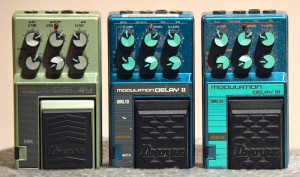I admit – I’m a delay junkie! Not that I normally drown my guitar parts in delay – I tend to use them more for ”space” and to fill out the sound – but I do have three delays on my main pedalboard, so I still probably qualify as some kind of delay nut… No reverbs yet – almost all my amps have onboard spring reverb, which I tend to use the same way as the delays. But if I do buy a separate reverb, it’ll end up in this post…
Mooer Echolizer

Lately I’ve been looking at scaling down my pedalboard, but since I (of course) don’t really want to cut down on the number of pedals, I’ve also started looking at smaller size ones. Enter Mooer… I tried all of the ones my local store had in stock, and kept two (the Black Secret and Trelicopter). This one came in from Singapore, along with the Ensemble King chorus. It’s a very basic echo/delay, with repeats that are quite distinctly filtered, both in the treble and bass ranges. This means you have a great meat-and-potatoes delay, which places itself very distincly behind the dry signal. I’d happily compare it to a Mad Professor Deep Blue Delay or any other heavy filtered PT2399-based digital delay. It’s perfect for the type of delay that appears to bloom between the notes, while staying well behind when your playing. The two small knobs have been treated to white pointers courtesy of some white-out (dab it in the groove, and when it’s dried scrape off any excess with a sharp knife). Other than that, the pedal needs no fixing. It’s just as good as I hoped, and for the price (and size) it’s just superb. If you’re looking for a basic delay with repeats that aren’t crystal clear, that is 🙂
TC Electronic Flashback Mini
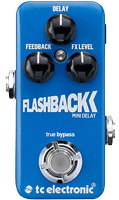
My trusty Ibanez DML10 has been my staple for slightly modulated delay for ages now, but the pedal is a bit of a one-trick pony. It is a good trick, but still… And using the 11Rack rig with expression controllers has made me accustomed to being able to adjust several parameters at once, in unison. I love being able to adjust the echo level and have the feedback also increase, so you can go from a standard setting to a washed-out droning sound in one go. One day, I realized the Toneprint feature in the Flashback Mini will let you do just that. You can program what the knobs should do, including having each one control up to three parameters. So I bought one, quickly dialed up a tape echo sound and made the ”fx level” knob control both the echo level and the feedback. I then spent some time adjusting the curve of both parameters so that when I go from 10 o’clock to about 2 o’clock on the ”echo level” dial, the echo goes from normal to very washed-out drone – perfect! I then mapped the ”feedback” knob to control the modulation mix (mostly because I wanted it do do something), and adjusted the delay time range so it fell within the range I needed. So far, it works a treat!
I’m still working on how to get the modulation to sound more like tape warble and less like a chorus (on the tape setting). And yes, on the 2290 with modulation setting, I am forever trying to emulate what the DML10 did, with its slightly detuned repeats (again, less chorus, more detune). But I will get there, some day 🙂
The toneprint app can ”beam” toneprints via the guitar’s pickups, and the latest version can also beam user toneprints. I haven’t tried it yet, though, so I can’t say how well it works. I do use the editor for the iPad (with a camera kit, to get an USB out) to tweak my toneprints, and it remains to be seen how well the iPhone editor works in that regard. I also need to work out some sort of rubber thingy for the ”fx level” knob, so I can tweak it with my foot…
Ibanez DL-5 Digital Delay (x2)
When I finished my true bypass loop strip (taking all pedals not in use out of the signal path), the signal loss caused by my DanEcho became all too apparent. It wasn’t something I’d noticed much before (when the signal passed through it at all times), but since the true bypass loop took it completely out of the signal path when it wasn’t being used, its sonic impact became quite clear. It had to go. A few minutes on eBay later, I’d snagged a near-mint DL-5. 🙂 The Soundtank digital delay uses a digital delay chip which was designed for karaoke machines (you know that crappy karaoke echo – this is it!). Its original limit was 100ms, but Ibanez boosted it to produce 400ms with reasonable fidelity. It sounds very warm and musical – not analog as such, but more like a good Boss DD-2. I’ve also rolled off a little treble from the delay signal, to place it a little more underneath the dry signal. I later bought a second DL5, partly for use on an additional board and partly as a spare. I wouldn’t recommend any of the Soundtank series pedals to heavy stompers or people who regularly plug in/unplug them – they are plastic and the jacks are supported only by the solder joints to the circuit board. Relatively quickly, Ibanez’ catch phrase for the Soundtank series – ”Built to withstand the stomp of Godzilla” – proved to be a slight exaggeration 🙂 But if you keep it on a pedalboard, and especially if you use a loop strip (so you don’t even have to step on it to turn it on/off), it’ll work just fine.
Ibanez Digital Modulation Delay (x3)
My not-so-hidden weapons… Years ago, I found the DML10 (Digital Modulation Delay II) and it quickly became a staple sound for me. A reasonably clear (slightly high-cut by me) digital delay with modulation added, for just a touch of warble. It is a digital delay with modulation capability, which means it can do chorus, flanger, straight delay or just downright sickly effects. For chorusing, you normally use short delay times (less than 20 ms) and adjust the modulation knobs to taste. To turn it into a flanger, shorten the delay time even more and maybe turn the feedback knob up a notch or two. But it’s really… erm… interesting to use a long delay time instead – with the width/speed knobs around 12 o’clock, the delay repeats changes pitch wildly, sometimes as much as an octave up & down… The word ”seasick” just doesn’t do enough to describe the sensation… I tend to use it in a slightly more moderate fashion – around 350 ms with just a hint of modulation. This just makes the sound ”shimmer” a bit. Basically, it makes the guitar sound beautiful. Now, choruses tend to become a bit overbearing as soon as overdrive is involved, but this stays lush and discrete, while just thickening the sound a bit. The ”width” knob needs careful setting, for this to work – move it a fraction of a hair, and the modulation will be too much. But set it just so, and it will deliver. If you’re after a slightly warbly pseudo-tape echo type sound, of course 🙂
I later bought the DML20 (Digital Modulation Delay III) for use on a second board. It differs from the DML10 in that it has slightly longer max delay time (1024ms instead of 900ms), a more clearly marked mode selector (with labels for ”chorus”, ”flanger” etc) and slightly brighter repeats. It uses a different delay chip than the earlier models, and has had a few other changes too (the picture to the right shows the back of the main circuit board of the DML, DML10 and DML20, in that order). But even so, it sounds nearly the same. The repeats are just a tad brighter. It’s the same old story, it seems – with every update made during the early days of digital effects, the pedals got more clean/clear (it’s the same with the Boss DD-2/3). I guess it was the preferred direction at the time, but these days, I tend to prefer the older, more grimy-sounding ones.
Then the DML (Digital Modulation Delay) arrived at my door, and it seems to support the theory – this was the first in the series, and it does indeed sound a little smoother and less bright. It is limited to 512ms delay time, but uses the same delay chip and is otherwise very similar to the DML10. And after a slight treble cut on the delay signal, it sounds wonderful!
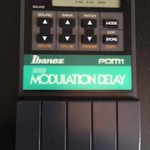
Oh, and if anyone has a PDM-1 (the modulation delay from the programmable DCP series) gathering dust, I’m interested – obviously, it was the next step in the series, and I’m curious to see how it holds up (and if the ”new and improved = brighter/clearer” theory holds up). So if you have one you’re willing to let go, shoot me an e-mail at andreas(at)stinkfoot.se!
Ibanez EM5 Echomachine
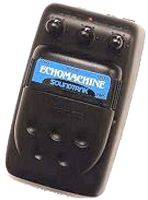
The Soundtank series was originally introduced in 1989, as a replacement for the ”10” series, and featured a sturdy metal housing. Sometime in the early ’90s the line was expanded, and at the same time redesigned with plastic housings, which wasn’t exactly Ibanez’s brightest moment. At least not from a reliability standpoint. Still, many of these pedals seem to have survived years of abuse, so what do I know? But I prefer to be a little careful when handling them – the pots are mounted directly to the circuit board, with plastic axles that protrude through the pedal’s shell – which means that they will snap off in a heartbeat if you bump the pedal the wrong way. Still, there are some gems to be found in this series too. The EM5 was introduced in the summer of 1997, which was rather late in this series’ life – the bugs were finally dropped in 1999. It is a digital delay, designed to mimic the sound of a tube tape echo. Many have tried their hand at that before, but this is the only delay/echo pedal I know of that actually has a distortion circuit built into the delay circuit, to mimic the distortion generated inside an Echoplex. Does it work? The answer is – as usual – both yes and no. The pedal does sound much more ”alive” than a regular digital delay, and there is a faint break-up in the signal which somewhat reminds me of an Echoplex. The EM5 is a great rockabilly/bathroom/slap-back type echo, and it also does an awesome background drone effect. With the feedback knob on (or very close to) max, this particular pedal will keep echoing everything you play indefinitely (adding layer after layer of sounds into the mix, which will get more and more garbled and distorted with each repeat), but it will never run away from you – it does not take off into uncontrolled self-oscillation. It’s an awesome sound, especially with the baritone guitar, which creates a very eery background texture to some of the more Daniel Lanois-influenced stuff I play.
Boss DD-3 (x2)
Both are the first version of the DD-3, which was the same as the DD-2, except for the name (obviously) and the dry output, which in the DD-2 was a parallel delay output. One is broken and in bits – one of those never-ending ”I’ll fix it when I get the time” projects – while the other is working fine and has been modified with a three-way treble cut switch. I planned on using it on my big/main board, but the Boss does something to the dry sound which I’m not too happy about. I’m guessing it’s the compander/expander circuit that makes its presence a little too known for my taste. Most people probably don’t notice this, as they run the signal through the pedal at all times (turning the delay on/off from the pedal itself). On that board I used a true bypass loop strip to turn my delays on/off independently, and the difference was quite apparent. Eventually, the DL5 won out – it just seemed to suit my playing style a litte better, and didn’t change my dry tone either. Again, it’s probably not something most people would even notice, but it bugged me a little too much.
Danelectro DanEcho
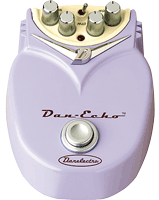
I bought this one off eBay in USA. I saw it in the listings with no bids and a $60 Buy-it-Now, so I snapped it up before anyone even had the chance to bid. With shipping costs, I ended up paying $82 – maybe a bit high for the US market, but as it retailed for the equivalent of $155 new here in Sweden, it was a good deal for me. But why the DanEcho? Well… it is a great echo/delay, basically 🙂 And I came across it by accident – one day at a rehearsal/recording, I was looking for something to add a little spice to a song. In a corner I spied a purple box that turned out to be a DanEcho. I plugged it in, and there it was! The repeats were mushy enough that one delay time basically worked for every song – I have been rather picky about my delay pedals having a tap tempo function, but this one don’t need it – and it just made everything that much thicker. I loved it! I didn’t particularly love what it did to my bypassed sound, though – its input buffer seems to suck all life out of the tone. Whatever you do – don’t plug your guitar straight into this one… The input impedance of the circuit is too low. What you can do, is make sure there’s a buffered (Boss or similar) pedal in front of the DanEcho – that will restore most of the tone lost. But the pedal really needs an input impedance of at least 470K to work properly in a guitar setup – I know of one guy who added a separate op-amp based input buffer to the start of the circuit, and that seems to do the trick. Anyway, the pedal has since been retired from my pedalboard – another pedal in the ”not currently in use” box, then…

